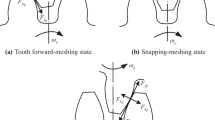Abstract
The objective of this research work is to provide a systematic method to perform molecular dynamics simulation or evaluation for adhesion of micro/nano gear train during sliding friction in MEMS. In this paper, molecular dynamics simulations of adhesion problems in micro gear train are proposed. The perfect MEMS gear train model is very complicated by considering the computing time. A simplified model to simulate surface sliding between metals by molecular dynamics (MD) is proposed because the surface property is a dominant factor for the performance of gear systems. Based on analysis of sliding friction and the transmitting characteristics of micro gear train, a model is established by utilizing the Morse potential function. The Verlet algorithm is employed to solve atom trajectories. The simulation results show that adhesion tends to occur between two micro gears after certain cycles and such adhesion accounts for the friction force and the temperature increase. The simulation results are in consistence with the experimental results in the literature. The model is meaningful to prolong the lifetime of micro gear train by selecting proper parameters.







Similar content being viewed by others
References
Albers A, Burkardt N, Marz J (2003) Restrictions in the design of gear wheel components and drives for micro technology. Microsyst Technol 9(3):192–196
Alder BJ, Wainwright TE (1957) Phase transition for a hard-sphere system. J Chem Phys 27:1208–1209
Ando Y, Ino J (1996) Friction and pull-off force on silicon surface modified by FIB. Sens Actuators 57(2):83–89
Chandrasekaran N (2001) Molecular dynamics simulations of machining, materials testing, and tribology at the atomic scale. Dissertation abstracts international, Vol. 62–08, Sect. B, pp 3763, Ranga Komanduri (adviser)
Douglass MR (1998) Lifetime estimates and unique failure mechanisms of the digital micromirror device (DMD). In: 36th IEEE international reliability physics symposium proceedings, IEEE, New York, pp 9–16
Fang T-H, Weng C-I, Chang J-G (2003) Molecular dynamics analysis of temperature effects on nanoindentation measurement. Mater Sci Eng A A 357:7–12
Granick S (1999) Soft matter in a tight spot. Phys Today 7:26–31
He G, Robbins MO (2001) Simulations of the kinetic friction due to adsorbed surface layers. Tribol Lett 10:7–14
He G, Muser MM, Robbins MO (1999) Adsorbed layers and the origin of static friction. Science 284:1650
Iwasaki T (2000) Molecular dynamics study of adhesion strength and diffusion at interfaces between interconnect materials and underlay materials. Comput Mech 25:78–86
Krim J (2002) Surface science and the atomic-scale origins of friction: what once was old is new again. Surf Sci 500(1–3):741–758
Li B, Clapp PC, Rifkin JA, Zhang XM (2003) Molecular dynamics calculation of heat dissipation during sliding friction. Int J Heat Mass Transf 46:37–43
Liu H, Bhushan B (2003) Nanotribological characterization of molecularly-thick lubricant films for applications to MEMS/NEMS by Atomic Force Microscopy. Ultramicroscopy 97(1–4):321–40
Maboudian R, Ashurst WR, Carraro C (2002) Tribological challenges in micromechanical systems. Tribol Lett 12:95–100
Minerva G-M, Fernando B, Jos A (2005) Molecular dynamics simulations of the surface tension of ionic liquids. J Chem Phys 122(10):1–8
Sasaki K, Seki Y (2000) Molecular dynamics simulation of adhesive and wear. JSME Int J Ser A 43(1):26–32
Takeuchi H, Nakamura K, Shimizu N, Shibaike N (2000) Optimization of mechanical interface for a practical micro-reducer. MEMS 2000. In: Proceedings IEEE 13th international symposium micro electro mechanical systems, 2000, pp 170–175
Tanner DM (2000) Reliability of surface micromachined MEMS actuators. In: Proceedings of the 22nd international conference in microelectronics, NIS, Yugoslavia, May 2000, pp 97–104
Tanner DM, Walraven JA, Irwin LW, Dugger MT, Smith NF, Eaton WP, Miller WM, Miller SL (1999) The effect of humidity on the reliability of a surface micromachined microengine. In: 37th IEEE international reliability physics symposium proceedings, IEEE, New York, pp 189–197
Vamvakopoulos E, Papageorgiou DG, Evangelakis GA (2005) Solidification of Pb overlayer on Cu(111) surface by molecular dynamics simulation. Thin Solid Films 485(1–2):290–295
Zhong HY, Hui W, Kun Z, Tao ZG (2000) Superlubricity, interfacial friction and dissipation—some aspects on fundamental study of friction. Tribology 20(4):313–316
Acknowledgments
The author would like to acknowledge the support of the National Science Foundation of China, the support of the National Defense Science Foundation of China, International cooperative Project of Jiangsu Province, Special Science Foundation for doctoral unit of China, the Natural Science Foundation of Guangxi Province of China, the support program for Young and Middle-aged Disciplinary Leaders in Gangxi Higher Education Institution and Natural Science Foundation for Qualified Personnel of Jiangsu University during the course of this work.
Author information
Authors and Affiliations
Corresponding author
Rights and permissions
About this article
Cite this article
Ping, Y., Ning Bo, L., Daoguo, Y. et al. Sliding simulation for adhesion problems in micro gear trains based on an atomistic simplified model. Microsyst Technol 12, 1125–1131 (2006). https://doi.org/10.1007/s00542-006-0235-7
Received:
Accepted:
Published:
Issue Date:
DOI: https://doi.org/10.1007/s00542-006-0235-7



